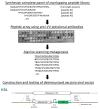Design and Engineering of Deimmunized Vaccinia Viral Vectors
- PMID: 33187060
- PMCID: PMC7697509
- DOI: 10.3390/biomedicines8110491
Design and Engineering of Deimmunized Vaccinia Viral Vectors
Abstract
Vaccinia viral (VV) vectors are increasingly used in oncolytic virus therapy and vaccine development for cancer and infectious diseases. However, their effectiveness is hindered by the strong anti-viral immune response induced by the viral vector. In this review, we discuss the strategies to deimmunize vaccinia viral vector. One approach is to mask the virus from the neutralization antibody responses by mapping and eliminating of B-cell epitopes on the viral membrane proteins. The recombinant VVs contain one or more viral glycoproteins with mutations in the neutralizing antibody epitopes, resulting in viral escape from neutralization. In addition, a regulator of complement activation (e.g., CD55) can be expressed on the surface of the virus particle, leading to increased resistance to complement-mediated neutralization.
Keywords: complement; deimmunization; immunogenicity; neutralizing antibody; oncolytic vaccinia virus.
Conflict of interest statement
Kevin Song is an intern of Icell Kealex Therapeutics. Kevin Song’s current contact information: DeBakey High School for Health Professions. Mariya Viskovska is an employee of Icell Kealex Therapeutics.
Figures


Similar articles
-
New p35 (H3L) Epitope Involved in Vaccinia Virus Neutralization and Its Deimmunization.Viruses. 2022 Jun 5;14(6):1224. doi: 10.3390/v14061224. Viruses. 2022. PMID: 35746695 Free PMC article.
-
Generation of novel oncolytic vaccinia virus with improved intravenous efficacy through protection against complement-mediated lysis and evasion of neutralization by vaccinia virus-specific antibodies.J Immunother Cancer. 2023 Jan;11(1):e006024. doi: 10.1136/jitc-2022-006024. J Immunother Cancer. 2023. PMID: 36717184 Free PMC article.
-
Potent neutralization of vaccinia virus by divergent murine antibodies targeting a common site of vulnerability in L1 protein.J Virol. 2014 Oct;88(19):11339-55. doi: 10.1128/JVI.01491-14. Epub 2014 Jul 16. J Virol. 2014. PMID: 25031354 Free PMC article.
-
Oncolytic herpes simplex virus tumor targeting and neutralization escape by engineering viral envelope glycoproteins.Drug Deliv. 2018 Nov;25(1):1950-1962. doi: 10.1080/10717544.2018.1534895. Drug Deliv. 2018. PMID: 30799657 Free PMC article. Review.
-
New viral vectors for infectious diseases and cancer.Semin Immunol. 2020 Aug;50:101430. doi: 10.1016/j.smim.2020.101430. Epub 2020 Nov 29. Semin Immunol. 2020. PMID: 33262065 Review.
Cited by
-
New p35 (H3L) Epitope Involved in Vaccinia Virus Neutralization and Its Deimmunization.Viruses. 2022 Jun 5;14(6):1224. doi: 10.3390/v14061224. Viruses. 2022. PMID: 35746695 Free PMC article.
-
Vaccinia Virus Attenuation by Codon Deoptimization of the A24R Gene for Vaccine Development.Microbiol Spectr. 2022 Jun 29;10(3):e0027222. doi: 10.1128/spectrum.00272-22. Epub 2022 May 18. Microbiol Spectr. 2022. PMID: 35583360 Free PMC article.
-
Oncolytic Virotherapy: From Bench to Bedside.Front Cell Dev Biol. 2021 Nov 26;9:790150. doi: 10.3389/fcell.2021.790150. eCollection 2021. Front Cell Dev Biol. 2021. PMID: 34901031 Free PMC article. Review.
-
Oncolytic virotherapy: basic principles, recent advances and future directions.Signal Transduct Target Ther. 2023 Apr 11;8(1):156. doi: 10.1038/s41392-023-01407-6. Signal Transduct Target Ther. 2023. PMID: 37041165 Free PMC article. Review.
-
Oncolytic Virus Immunotherapy: Showcasing Impressive Progress in Special Issue II.Biomedicines. 2021 Jun 10;9(6):663. doi: 10.3390/biomedicines9060663. Biomedicines. 2021. PMID: 34200560 Free PMC article.
References
Publication types
Grants and funding
LinkOut - more resources
Full Text Sources
Other Literature Sources
Miscellaneous

